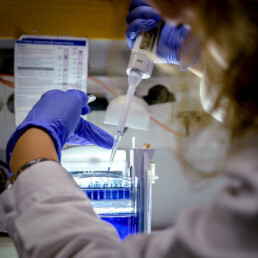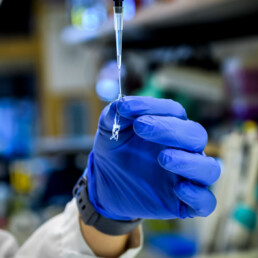Opportunity
The Unique Concept
The Xinnate concept is based on our patented TCP-25 platform, a peptide which is part of the human natural defence system. The mode of action is very well understood and published in high impact journals such as Nature Communications. The uniqueness of the TCP-25 based drug is threefold.
A. Targeting inflammation and infection
There is a great and unmet need for new innovative products that can both reduce inflammation and prevent infection. Any damage to the skin barrier imposes a risk of infection. In severe cases, bacteria can be released into the bloodstream and released endotoxins can cause an excessive and sometimes lethal inflammatory response, i. e. sepsis.
Today´s treatments, targeting microbes with antibiotics, are only able to remove the invading bacteria, but they don’t address the inflammation.
Figure 1 – Illustration of the mode of action of BioC hydrogel. BioC scavenges endotoxins and binds to bacteria, leading to reduced inflammation but with retained bacterial and toxin clearance. Inflammation is therefore controlled. BioC in the hydrogel has a direct killing effect on bacteria in addition.
Anti-inflammatory – naturally managing the paradox keeping the initial healthy level of inflammation and quenching the excessive damaging systemic inflammation.
Inflammation is a natural reaction during healing but in the presence of bacteria, bacterial endotoxins or other pro-inflammatory substances, uncontrolled and excessive inflammation can cause impaired healing. Therefore, targeting inflammation in combination with infection will decrease healing time and improve end result.
Anti-infective – for prevention and early treatment of infections. It is effective on both gram-positive and gram-negative bacteria and also on drug resistant bacteria. Infection related diseases are causing millions of deaths and entails huge costs worldwide and this will increase.
Dual effect – no drug with a similar dual effect exists today, and this broad biological effect enables an extensive range of target indications, such as inflammatory skin diseases, acute and chronic wounds, but also other applications such as post cosmetic treatment and coatings of surgical sutures and other biomaterials in skin contact (catheters, ostomy, skin replacement materials)
B. Replacing and reducing the use of antibiotics
Infections are typically prevented and treated with antibiotics. The excessive utilisation of antibiotics, however, has generated an increasing range of bacteria that are resistant. This means, that in the future there will be infections where antibiotics are not effective, and that we in the future will have to restrain the use of the remaining effective antibiotics to the most critical situations. The expected future limited efficiency and availability of antibiotics will mean that preventive care will become increasingly important – we therefore need more efficient and sustainable drugs that target infection and, maybe more importantly, inflammation at an early stage.
C. Replacing and reducing the use of other anti-infective substances with negative side effects
Current topical wound treatments are based on anti-infective components (iodine, silver, PHMB). These substances are all, in different ways, potentially harmful for the environment and/or the patient. There is thus a need to replace the current use of antiseptic treatments with more efficient alternatives without negative side effects.
Read more about:




